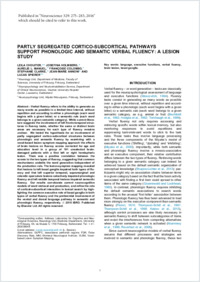Partly segregated cortico-subcortical pathways support phonologic and semantic verbal fluency: A lesion study
- Chouiter, Leila Neurology Unit, Department of Medicine, Faculty of Sciences, University of Fribourg, Switzerland - Neuropsychology Unit, Hôpital fribourgeois, Fribourg, Switzerland
- Holmberg, Josefina Neurology Unit, Department of Medicine, Faculty of Sciences, University of Fribourg, Switzerland
- Manuel, Aurelie L. Neuropsychology and Neurorehabilitation Service, Department of Clinical Neurosciences, Vaudois University Hospital Center, Lausanne, Switzerland
- Colombo, Françoise Neuropsychology Unit, Hôpital fribourgeois, Fribourg, Switzerland
- Clarke, Stephanie Neuropsychology and Neurorehabilitation Service, Department of Clinical Neurosciences, Vaudois University Hospital Center, Lausanne, Switzerland
- Annoni, Jean-Marie Neurology Unit, Department of Medicine, Faculty of Sciences, University of Fribourg, Switzerland
- Spierer, Lucas Neurology Unit, Department of Medicine, Faculty of Sciences, University of Fribourg, Switzerland
-
04.08.2016
Published in:
- Neuroscience. - 2016, vol. 329, p. 275–283
English
Verbal fluency refers to the ability to generate as many words as possible in a limited time interval, without repetition and according to either a phonologic (each word begins with a given letter) or a semantic rule (each word belongs to a given semantic category). While current literature suggests the involvement of left fronto-temporal structures in fluency tasks, whether the same or distinct brain areas are necessary for each type of fluency remains unclear.We tested the hypothesis for an involvement of partly segregated cortico-subcortical structures between phonologic and semantic fluency by examining with a voxel-based lesion symptom mapping approach the effects of brain lesions on fluency scores corrected for age and education level in a group of 191 unselected brain-damaged patients with a first left or right hemispheric lesion.There was a positive correlation between the scores to the two types of fluency, suggesting that common mechanisms underlie the word generation independent of the production rule. The lesion-symptom mapping revealed that lesions to left basal ganglia impaired both types of fluency and that left superior temporal, supramarginal and rolandic operculum lesions selectively impaired phonologic fluency and left middle temporal lesions impaired semantic fluency.Our results corroborate current neurocognitive models of word retrieval and production, and refine the role of cortical- subcortical interaction in lexical search by highlighting the common executive role of basal ganglia in both types of verbal fluency and the preferential involvement of the ventral and dorsal language pathway in semantic and phonologic fluency, respectively.
- Faculty
- Faculté des sciences et de médecine
- Department
- Médecine 3ème année
- Language
-
- English
- Classification
- Biological sciences
- License
-
License undefined
- Identifiers
-
- RERO DOC 277410
- DOI 10.1016/j.neuroscience.2016.05.029
- Persistent URL
- https://folia.unifr.ch/unifr/documents/305103
Statistics
Document views: 115
File downloads:
- pdf: 246
